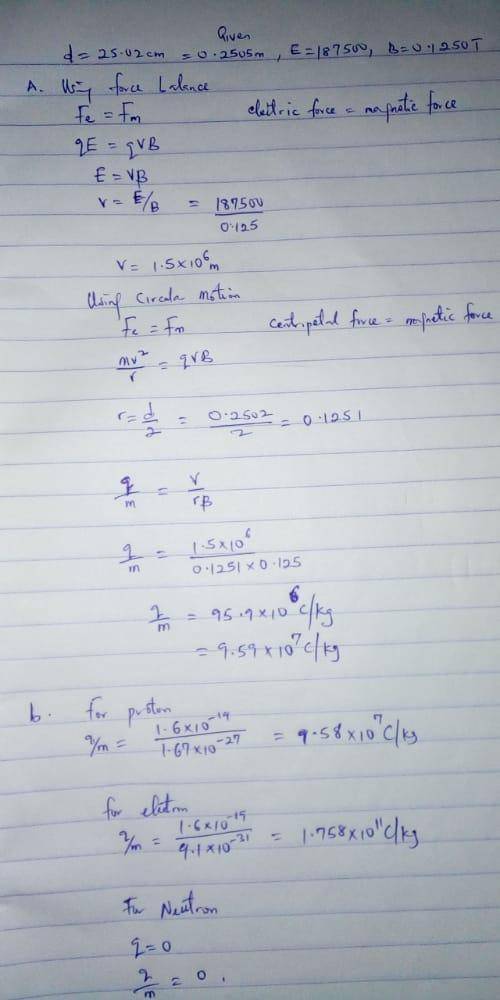
1. An unknown charged particle passes without deflection through crossed electric and magnetic fields of strengths 187,500 V/m and 0.1250 T, respectively. The particle passes out of the electric field, but the magnetic field continues, and the particle makes a semicircle of diameter 25.05 cm.
Part A. What is the particle's charge-to-mass ratio?
Part B. Can you identify the particle?
a. can't identify
b. proton
c. electron
d. neutron
2. A neutral lithium atom has three electrons. Two of these electrons form an "inner core," but the third-the valence electron-orbits at a much larger radius. From the valence electron's perspective, it is orbiting a spherical ball of charge having net charge +1e (i. e., the three protons in the nucleus and the two inner-core electrons). The energy required to ionize a lithium atom is 5.14 eV. Hint: Consider the energy needed to remove the electron and the force needed to give the electron a circular orbit.
Part A. According to Rutherford's nuclear model of the atom, what is the orbital radius of the valence electron? Express your answer with the appropriate units.
Part B. According to Rutherford's nuclear model of the atom, what is the speed of the valence electron? Express your answer with the appropriate units.

Answers: 1
Other questions on the subject: Physics

Physics, 21.06.2019 22:50, Bt758
Two horizontal plates with infinite length and width are separated by a distance h in the z direction. the bottom plate is moving at a velocity u. the incompressible fluid trapped between the plates is moving in the positive x-direction with the bottom plate. align gravity with positive z. assume that the flow is fully-developed and laminar. if the systems operates at steady state and the pressure gradient in x-direction can be ignored, do the following: 1. sketch your system 2. identify the coordinate system to be used. 3. show your coordinates and origin point on the sketch. list all your assumptions. 5. apply the continuity equation to your system. nts of navier stokes equations of choice to your system 7. solve the resulting differential equation to obtain the velocity profile within the system make sure to list your boundary conditions. check units of velocity 8. describe the velocity profile you obtain using engineering terminology. sketch that on the same sketch you provided in (1). 9. obtain the equation that describes the volumetric flow rate in the system. check the units.
Answers: 2

Physics, 22.06.2019 05:10, zionnahl
Total solidification times of three casting geometries are to be compared: a sphere, a cylinder, in which the length-to-diameter ration - 1.0, and a cube. volume = 1000 cm^3 for all three shhapes, and the same casting alloy is used. a) determine the solidification times of each geometry b) based on the results of part (a), which geometric element would make the best riser? c) if the mold constant = 3.5 min/cm^2 in chvorinov's rule, compute the total solidification time for each casting.
Answers: 3

Physics, 22.06.2019 14:30, uwunuzzles
Lightning is an example of what phenomenon? a release of a large amount of energyan absorption of a large amount of energya natural electric circuita natural electric current
Answers: 1

Physics, 23.06.2019 00:20, evan1v1123
You are the coordinator for a program that is going to take place at night in a rectangular amphitheater in the mountains. you will have no access to any electricity, but you must be able to illuminate the entire grounds. you know the intensity of the light from a lantern varies inversely as the square of the distance from the lantern. suppose the intensity is 90 when the distance is 5 m. a. write an equation to model the situation. b. solve for the constant of variation. c. write the equation to model the situation using the constant () of variation. d. you have been given lanterns with 40 light intensity. use your equation to solve for the distance from the lantern. e. you need to illuminate 225 km. how many meters do you need to light? f. how many lanterns will you need?
Answers: 3
Do you know the correct answer?
1. An unknown charged particle passes without deflection through crossed electric and magnetic field...
Questions in other subjects:

English, 15.06.2020 22:57

Mathematics, 15.06.2020 22:57

Mathematics, 15.06.2020 22:57


Mathematics, 15.06.2020 22:57


Mathematics, 15.06.2020 22:57

Medicine, 15.06.2020 22:57

Mathematics, 15.06.2020 22:57

English, 15.06.2020 22:57







